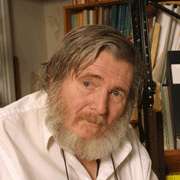Em 30 de novembro passado, morreu, em Boston, o Professor John Strugnell, aos 77 anos (1930-2007).
Strugnell trabalhou cerca de 40 anos com os Manuscritos do Mar Morto. Vi a notícia no PaleoJudaica.com, de Jim Davila, que trabalhou com ele nos Manuscritos na década de 80 e testemunha: “He was a giant in the field” [Ele era um gigante na área].
Sobre a publicação dos Manuscritos, escrevi em meu artigo Os Essênios: a racionalização da Solidariedade, no item Publicação:
“A leitura, tradução e publicação dos manuscritos mais ou menos completos não é um grande problema para os especialistas. Mesmo os fragmentos das grutas menores são publicados até os anos 70.
O problema está nos milhares de fragmentos de mais de 500 manuscritos da gruta 4. A maioria está muito deteriorada: corroídos, curvados, enrugados, retorcidos, cobertos por mofo e elementos químicos.
Para trabalhar nestes fragmentos é constituída em 1952 uma equipe internacional no Museu Arqueológico da Palestina, em Jerusalém Oriental, pertencente à Jordânia.
O chefe da equipe é o dominicano Roland de Vaux. Com ele trabalham Frank Moore Cross, americano, presbiteriano; J. T. Milik, polonês, católico; John Allegro, inglês, agnóstico; Jean Starcky, francês, católico; Patrick Skehan, americano, católico; John Strugnell, inglês, presbiteriano, depois católico; Claus-Hunno Hunziger, alemão, luterano. Predominam especialistas de Harvard (USA), École Biblique (Jerusalém) e Oxford (Inglaterra). Nota-se, nesta lista, a ausência de pesquisadores judeus. Dizem os especialistas que foi uma exigência do governo jordaniano.
Os trabalhos avançam em bom ritmo, já que são financiados por J. D. Rockfeller Jr., magnata americano. Mas, dois fatos intervêm: morre Rockfeller e Israel, na Guerra dos Seis Dias, em 1967, anexa Jerusalém Oriental e toma o Museu Arqueológico da Palestina onde estão os manuscritos da gruta 4. O projeto de publicação perde o compasso.
Com a morte de Roland de Vaux em setembro de 1971, a função de editor-geral passa para seu colega dominicano Pierre Benoit, que por sua vez, ao morrer em 1987, passa o cargo para John Strugnell [os preparativos para esta sucessão vinham desde 1984]. Durante todos estes anos, a equipe continua pequena. Quando um pesquisador morre ou se retira, é substituído por outro e pronto. Strugnell, porém, lutará por duas coisas: pela expansão do pequeno grupo original encarregado dos manuscritos e pela inclusão nesta equipe de pesquisadores judeus.
Entretanto, cresce no meio acadêmico mundial a insatisfação com a demora na publicação dos documentos. Alguns nomes se destacam neste protesto: Robert Eisenman, da Universidade do Estado da Califórnia e Philip R. Davies da Universidade de Sheffield, Reino Unido. Eles tentam o acesso aos manuscritos, mas são barrados por J. Strugnell. É então que entra em cena Hershel Shanks, fundador da Biblical Archaeology Society. Através da Biblical Archaeology Review, ele inicia, a partir de 1985, poderosa campanha em favor do livre acesso dos pesquisadores aos manuscritos ainda não publicados.
Após polêmica entrevista aos jornais, em dezembro de 1990, John Strugnell é demitido do cargo pela Israel Antiquities Authority (IAA), que indica Emanuel Tov como editor-chefe e amplia a equipe para cerca de 50 pesquisadores.
Contudo, dois novos fatos mudam o rumo das coisas. Em setembro de 1991 Ben Zion Wacholder e Martin Abegg do Hebrew Union College, em Cincinati, publicam A Preliminary Edition of the Unpublished Dead Sea Scrolls. Baseados no glossário elaborado pelos pesquisadores oficiais, e utilizando um computador, os dois estudiosos reconstroem textos inteiros da gruta 4. No mesmo mês, a Biblioteca Huntigton, de San Marino, Califórnia, que possui as fotos de todos os manuscritos, coloca a coleção à disposição dos estudiosos.
Em novembro de 1991 a Biblical Archaeology Society publica a Edição Fac-símile dos Manuscritos do Mar Morto, com cerca de 1800 fotografias dos manuscritos.
Neste meio tempo a IAA autoriza aos fotógrafos o acesso aos manuscritos. Estas fotografias estão disponíveis em 5 lugares: Jerusalém, Claremont e San Marino (as duas últimas na Califórnia), Cincinati e Oxford. E, finalmente, em 1993, sob os auspícios da IAA, sai a edição completa em microfilmes de todos os manuscritos do Mar Morto: The Dead Sea Scrolls on Microfiche. A Comprehensive Facsimile Edition of the Texts from the Judaean Desert, edited by Emanuel Tov with the collaboration of Stephen J. Pfann, E. J. Brill-IDC, Leiden 1993.
Em novembro de 2001 a publicação dos Manuscritos do Mar Morto foi concluída. Hoje há várias edições impressas e eletrônicas dos Manuscritos, além das páginas que os disponibilizam online”.
Para se compreender o episódio da demissão de John Strugnell é fundamental a leitura do comentário de Joe Zias ao post de Jim West John Strugnell’s Death [Obs.: blog apagado, link perdido]. Tenho gravado um documentário televisivo sobre os Manuscritos do Mar Morto, que uso em sala de aula, no qual este episódio é narrado. Pois para mim, a demissão de Strugnell, desde que vi aquele documentário, sempre me pareceu um equívoco: o que vi foi um grande intelectual, estressado e muito doente, que foi erroneamente julgado como anti-semita e injustamente punido. Joe Zias começa assim: A brilliant scholar and a decent man, mistreated by the press due to some medical problems which many people in the academic world suffer from. I knew John for many years…
